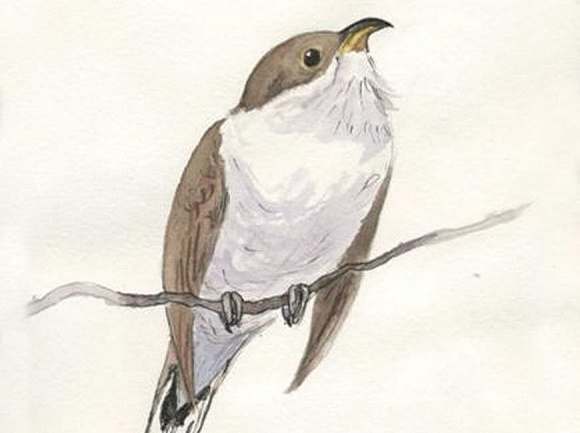There are certain sounds that haunt the southern highlands. Wind sighing in the high spruce-fir. The ongoing, ever-changing, yet-eternally-the-same murmurs of a creek. A little less than a century ago one could still hear from time to time the blood curdling howls and screams of timber wolves and panthers. Even today — if you go to some high-elevation outcrop — you might suddenly be galvanized by the “singing” tail of a timber rattler. And then there are the forlorn calls of the yellow-billed cuckoo.
In the excerpt from Wordsworth’s poem cited above, the poet was referring to the European cuckoo, but he aptly described the secretive habits of the yellow-billed cuckoo that breeds here in the southern highlands. No bird is more secretive. Seldom leaving the shrouding foliage, the cuckoo sits motionless. When it does move, the cuckoo creeps about with furtive restraint. Seeing one is possible but unlikely. For the most part, this is a bird that you hear. It is mostly a “voice” arising somewhere in the near distance.
Related Items
Many rural residents know this bird as the rain crow since its guttural “ka-ka-kow-kow-kowlp-kowlp-kowlp” calls are often sounded just prior to a late evening thunderstorm. (The distinctive “kowlp-kowlp-kowlp” portion of the call sounds something like a small dog barking.) The cuckoos on our property often sound a single “kowlp” note rather than the full vocalization.
Skeptics have dismissed the association of yellow-billed cuckoos and imminent rainfall, but the authors of Birds of the Carolinas (UNC Press, 1980) note that, “There may be some basis for this bit of folklore, because cuckoos apparently adjust the timing of their nesting effort to the temporary local abundance of suitable prey, which in many instances coincides with periods of rainfall.”
A second cuckoo species that nests here in the mountains, mostly in the upper elevations, is called the black-billed cuckoo because it lacks the yellow lower mandible of its cousin. I’ve never seen a black-billed cuckoo, but I have heard its rythmic “cu-cu-cu cu-cu-cu cu-cu-cu” calls on several occasions, most notably in the region of Blue Valley near Highlands, the Rainbow Springs section of the Nantahala River, and on the Balsam Mountain spur road of the Blue Ridge Parkway above Cherokee.
Both species winter in South America. They arrive in our region during the last week in April and usually depart by late October.
If you see a yellow-billed cuckoo in flight, the most distinctive feature will be a double row of large white spots beneath the tail. The reddish flash of wing against the brownish body is also diagnostic.
The European cuckoo is infamous as a result of its parasitic lifestyle; that is, it habitually lays its eggs in the nests of other birds so that the hosts will have to bear the energy costs of raising cuckoo babies. Our two species of cuckoo have occasionally been known to lay eggs in one another's nests or in the nests of other species. For the most part, however, they raise their own young.
The sight of the bird in flight or perched on a limb staring at you is one that's worth pursuing. As Henry David Thoreau, another 19th century bird-watcher, observed: “The cuckoo is a very neat, slender, and graceful bird. It belongs to the nobility of birds. It is elegant.”
(George Ellison is a naturalist and writer. He can be reached at This email address is being protected from spambots. You need JavaScript enabled to view it..)




